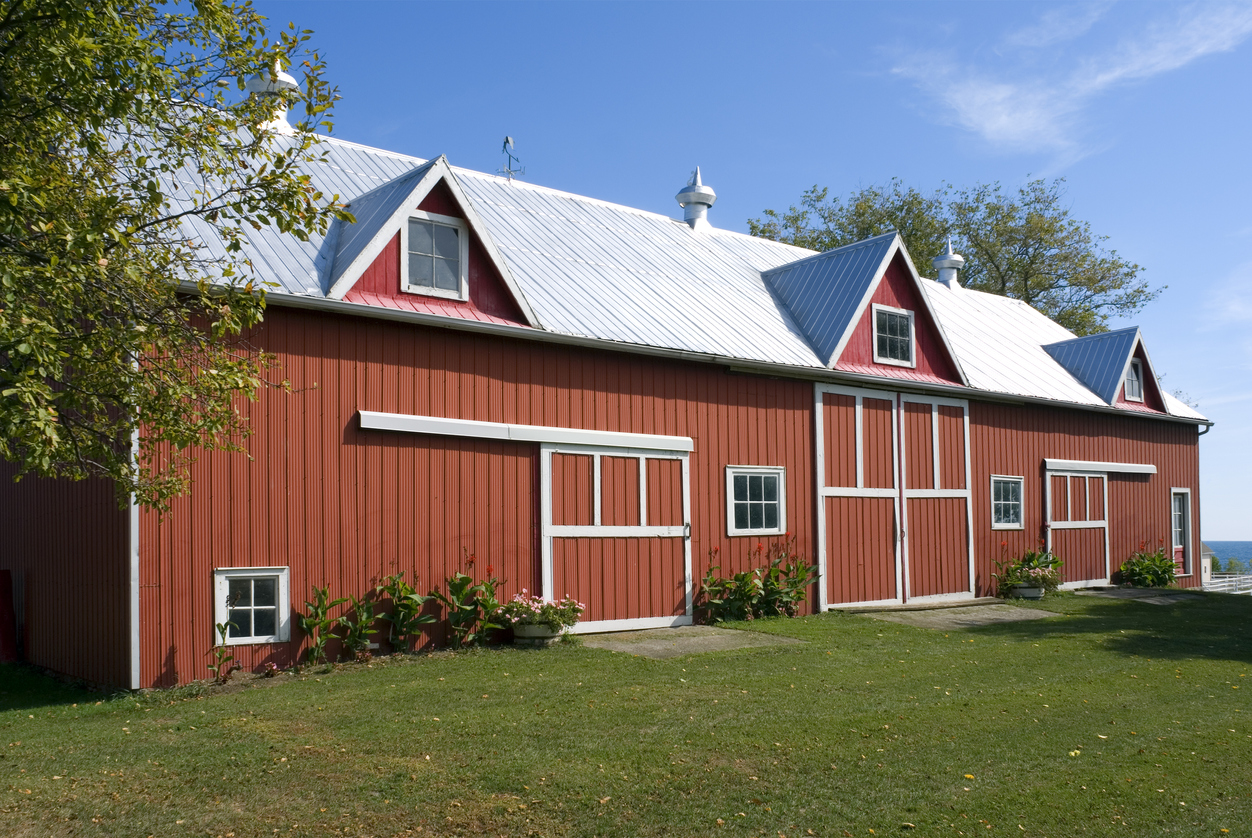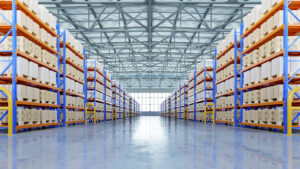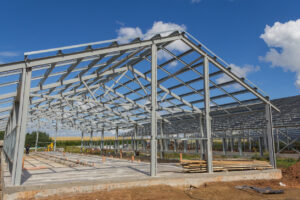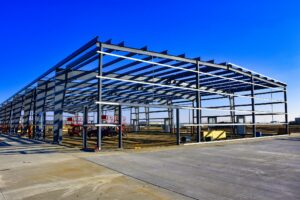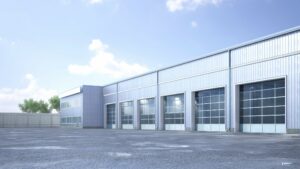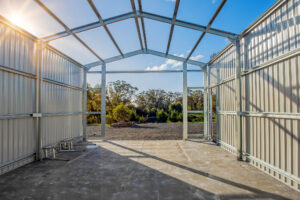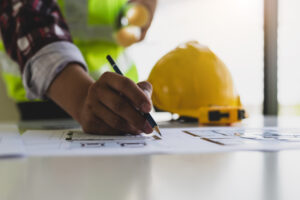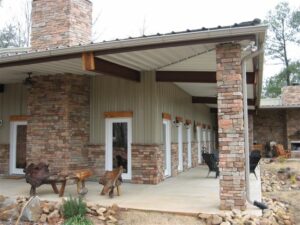Metal mall buildings or Metal Strip Malls are a unique type of commercial structure that provides a versatile and efficient space for multiple retail tenants.
These buildings are constructed primarily with steel, offering durability, cost-effectiveness, and sustainability.
In the past, metal building construction was primarily associated with commercial and industrial operations.
However, the market has expanded to include more public, government, and residential uses. Metal is now used for strip mall buildings, recreational areas, public parks, home garages, storage sheds, and other applications.
Table of Contents:
- Understanding the Concept of Metal Mall Buildings
- The Benefits of Metal Mall Buildings
- The Construction Process of Metal Mall Buildings
- Maintenance and Care for Metal Mall Buildings
- Future Trends in Metal Mall Buildings
- Conclusion
Understanding the Concept of Metal Mall Buildings
Metal mall buildings are designed to house multiple retail businesses under one roof. The concept allows for a centralized retail hub where customers can conveniently access various shops and services.
These buildings offer a range of unique features and benefits that make them highly desirable in the commercial construction industry.
Definition and Basic Features
Metal mall buildings, also known as shopping centers or strip malls, are typically single-story structures with multiple storefronts facing a common walkway or parking lot.
The buildings are designed to accommodate various types of businesses, including retail stores, restaurants, banks, and more. This design allows for optimal floor space utilization and ensures ease of accessibility for both customers and vendors.
History and Evolution of Metal Mall Buildings
The concept of a mall or shopping center can be traced back to ancient marketplaces that were often established as central gathering places for trade and commerce.
However, the modern metal mall buildings as we know them today emerged during the post-World War II era when the demand for retail spaces grew rapidly.
Steel became the material of choice due to its strength, flexibility, and cost-effectiveness.
As the popularity of metal mall buildings increased, architects and engineers began to explore innovative design techniques to enhance the functionality and aesthetics of these structures.
One notable development was the incorporation of skylights and large windows, allowing natural light to flood the interior spaces. This not only created a pleasant shopping environment but also reduced the need for artificial lighting, resulting in energy savings.
Furthermore, advancements in construction techniques and materials have contributed to the evolution of metal mall buildings. The introduction of pre-engineered metal building systems revolutionized the industry by providing faster construction times and improved structural integrity.
These systems utilize computer-aided design and manufacturing processes, ensuring precision and efficiency during the construction phase.
Did You Know?
The Rand McNally Building in Chicago, built in 1890, was the first all-steel-framed skyscraper. Designed by architects Burnham and Root, it stood ten stories tall and cost $1 million to build. Although it was demolished in 1911, it marked a significant milestone in steel-framed construction.
The Benefits of Metal Mall Buildings
Metal building strip malls offer numerous advantages that make them an attractive option for developers, tenants, and consumers alike. Let’s explore some of the key benefits in detail:
Durability and Longevity
One of the primary advantages of metal mall buildings is their exceptional durability and longevity.
Steel, the main construction material, is known for its strength and ability to withstand harsh weather conditions, including high winds, heavy snow loads, and seismic activity. This means that a metal mall building can stand tall and strong, providing a safe and secure environment for businesses and shoppers alike.
But it’s not just the weather that metal mall buildings can withstand. Steel is also resistant to pests, fire, rot, and corrosion, ensuring that the building maintains its structural integrity for decades.
This means that owners can have peace of mind knowing that their investment is protected and will continue to serve its purpose for many years to come.
Cost-Effectiveness and Efficiency
Metal mall buildings offer significant cost savings compared to traditional construction methods. Steel is readily available and cost-effective, making it an affordable option for developers. The prefabricated components of these buildings also reduce construction time and labor costs, allowing businesses to open their doors to customers sooner.
Furthermore, metal mall buildings require minimal maintenance, saving owners both time and money in the long run. With steel’s resistance to pests, fire, and corrosion, there is no need for costly repairs or constant upkeep.
This means that businesses can focus on what matters most—providing a great shopping experience for their customers.
Environmental Impact and Sustainability
With increasing concerns about sustainability and environmental preservation, metal mall buildings have gained popularity due to their green characteristics.
Steel is a recyclable material, and the construction process generates less waste compared to other building materials. This means that by choosing a metal mall building, developers are making a conscious choice to reduce their impact on the environment.
Additionally, metal mall buildings can incorporate energy-efficient features, such as insulation, LED lighting, and renewable energy sources. These features not only reduce energy consumption and utility costs but also contribute to a healthier and more sustainable future.
By embracing these green initiatives, metal mall buildings become more than just places to shop—they become symbols of responsible and forward-thinking development.
Did You Know?
The steel industry in the United States makes a significant contribution to climate preservation by producing approximately 70% of its steel from recycled materials.
The Construction Process of Metal Mall Buildings
The construction process of metal mall buildings is a complex and meticulous endeavor that requires careful attention to detail and expertise in various disciplines.
In addition to the key stages of design, planning, material selection, and building installation, several other crucial aspects contribute to the successful completion of these structures.
One important consideration in the construction of metal mall buildings is the incorporation of sustainable and environmentally friendly practices.
This includes the use of recycled materials, energy-efficient systems, and green building techniques to minimize the project’s carbon footprint and promote long-term sustainability.
By implementing these strategies, developers can create modern and eco-conscious retail spaces that align with current environmental standards.
Check out: DIY Steel Building: A Comprehensive Guide
Design and Planning
The design phase of metal mall buildings goes beyond just aesthetics; it involves creating functional and innovative spaces that cater to the diverse needs of retailers and customers.
Designers must carefully balance form and function, ensuring that the layout promotes efficient traffic flow, maximizes natural light, and provides a welcoming atmosphere for visitors.
Collaborating with architects, engineers, and interior designers is essential to achieve a cohesive and well-executed design that enhances the overall shopping experience.
Materials and Equipment
When selecting materials and equipment for metal mall buildings, developers prioritize durability, performance, and cost-effectiveness.
Steel frameworks are chosen for their strength and versatility, while advanced roofing systems offer superior weather protection and energy efficiency.
High-quality insulation, electrical components, and plumbing fixtures are integrated to enhance the building’s functionality and comfort. By investing in top-tier materials and equipment, construction teams can ensure the longevity and resilience of the mall structure.
Building and Installation
During the building and installation phase, skilled craftsmen and technicians work diligently to bring the architectural vision to life. Precision and accuracy are paramount as the metal structure is assembled according to intricate specifications.
Cutting-edge equipment and technology are utilized to streamline the construction process and maintain high standards of craftsmanship.
Regular quality checks and safety inspections are conducted to guarantee that the building meets industry regulations and exceeds client expectations.
Pro tip
Metal buildings support clearspan construction, a distinctive feature that allows the creation of spaces over 350 feet wide without any column support. If support columns are incorporated in the center of the building (known as multiple spans), they can be extended out on either side for a building over 500 feet in width.
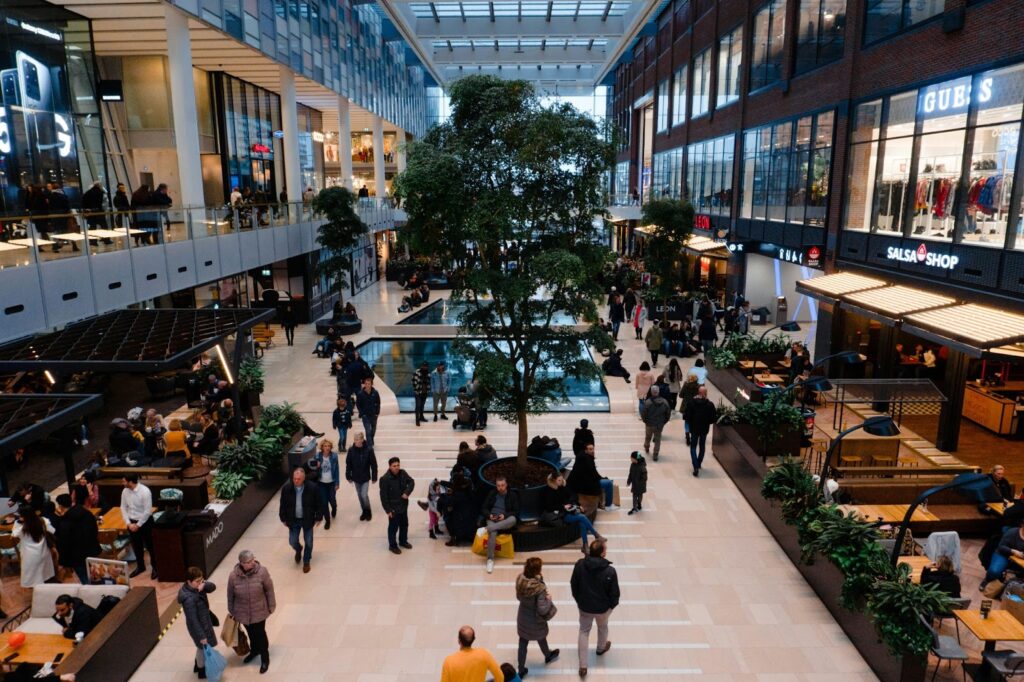
Maintenance and Care for Metal Mall Buildings
Proper maintenance and care are crucial for preserving the longevity and functionality of metal mall buildings. Consider the following practices:
When it comes to metal mall buildings, a proactive approach to maintenance is key to ensuring the safety and structural integrity of the property. In addition to regular upkeep practices, investing in preventive maintenance measures can help mitigate potential issues before they escalate, saving both time and money in the long run.
Regular Upkeep Practices
Regular maintenance routines, such as cleaning, inspection, and repair, should be performed to identify and address any potential issues. This includes maintaining the external facade, conducting regular plumbing and electrical inspections, and ensuring the proper functioning of heating, ventilation, and air conditioning systems.
Furthermore, implementing a comprehensive maintenance schedule that includes seasonal checks and routine assessments can help property owners stay ahead of any maintenance requirements, ensuring that the metal mall building remains in optimal condition throughout the year.
Potential Issues and Solutions
Like any structure, metal mall buildings may encounter specific challenges. Common issues include roof leaks, plumbing problems, electrical malfunctions, and wear and tear on interior surfaces.
It is essential to address these issues promptly by seeking the expertise of professionals to minimize disruptions and prevent further damage.
Moreover, conducting regular roof inspections and addressing any signs of deterioration can help prevent water infiltration and structural damage.
By partnering with experienced contractors and service providers, property owners can access specialized knowledge and resources. They can tackle maintenance issues effectively, ensuring the longevity and durability of the metal mall building.
Future Trends in Metal Mall Buildings
The future of metal mall buildings is driven by advancements in technology, evolving design trends, and a growing emphasis on sustainability in the construction industry. Here are some key trends to watch:
Technological Advancements
Emerging technologies, such as smart building systems, digital signage, and enhanced security systems, are likely to become prevalent in metal mall buildings.
These advancements aim to improve efficiency, enhance the customer experience, and ensure optimal management of the building’s operations.
Imagine walking into a metal mall building and being greeted by personalized digital signage that directs you to your favorite stores or displays real-time promotions.
Smart building systems will enable seamless integration of various technologies, allowing retailers to track foot traffic, analyze customer behavior, and optimize their operations.
Enhanced security systems will provide a safe and secure environment, utilizing advanced surveillance cameras, facial recognition technology, and access control systems.
Design and Aesthetic Trends
Metal mall buildings are increasingly incorporating contemporary design elements to create visually appealing spaces that attract customers. This includes the use of large windows for natural light, modern finishes, and innovative architectural features that provide a unique identity to each retail tenant.
Imagine strolling through a metal mall building with its sleek, modern design. Large windows allow natural light to flood the space, creating a welcoming and vibrant atmosphere.
The use of modern finishes, such as polished concrete floors and exposed metal beams, adds an industrial yet sophisticated touch. Innovative architectural features, like suspended walkways or living green walls, provide a unique and memorable shopping experience for visitors.
Sustainability and Green Building Practices
Given the global focus on sustainable construction, metal building strip malls are expected to adopt even more green building practices. This includes the integration of renewable energy systems such as solar panels, rainwater harvesting, and advanced waste management systems. These reduce the environmental impact and promote a healthier shopping experience.
Imagine stepping into a metal mall building that offers a wide range of retail options and prioritizes sustainability. Solar panels installed on the roof harness the power of the sun, providing clean and renewable energy to the building.
Rainwater harvesting systems collect and store rainwater for irrigation or flushing toilets, reducing the reliance on municipal water sources. Advanced waste management systems ensure proper recycling and disposal of waste, minimizing the environmental footprint of the mall.
Metal mall buildings offer retail businesses a modern, cost-effective, and sustainable space to thrive. With their countless benefits and ever-evolving trends, these structures continue to shape the future of commercial construction.
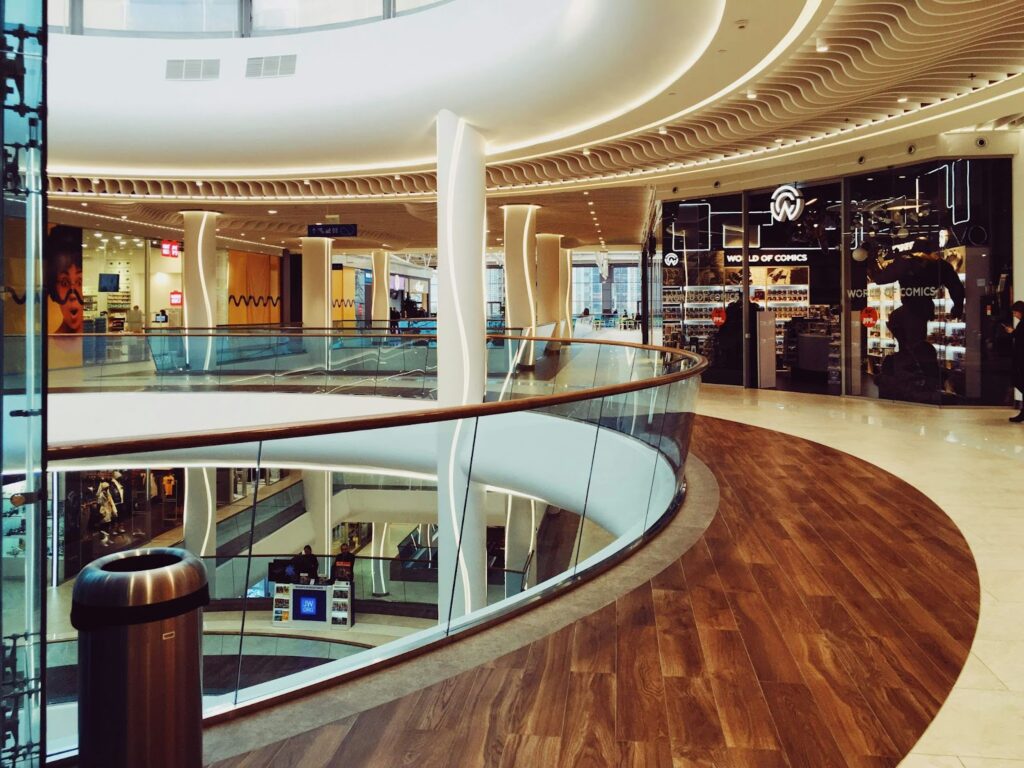
Conclusion
Metal buildings strip malls have revolutionized the retail industry by offering a versatile and efficient space for multiple businesses. Their durability, cost-effectiveness, and sustainability make them a favorable choice for developers and tenants.
With advancements in technology, metal mall buildings will play a vital role in the future of commercial construction.
SteelCo has 23+ years of experience dropshipping Pre-Engineered Metal Building (PEMB) materials, such as ones for commercial, retail, and mixed-use buildings, across the US. As a locally-awarded General Contractor, our expertise also extends to comprehensive commercial design-build and construction projects across Georgia for a wide range of client industries and asset classes.
We assist clients in navigating through local building ordinance codes and construction timelines, and provide conceptual designs and stamped engineering plans that simplify the process of obtaining necessary building permits and licenses.
————————–
Check out these related articles:
> Cooling Solutions For Metal Buildings
> Choosing The Right Colors For Your Metal Building









